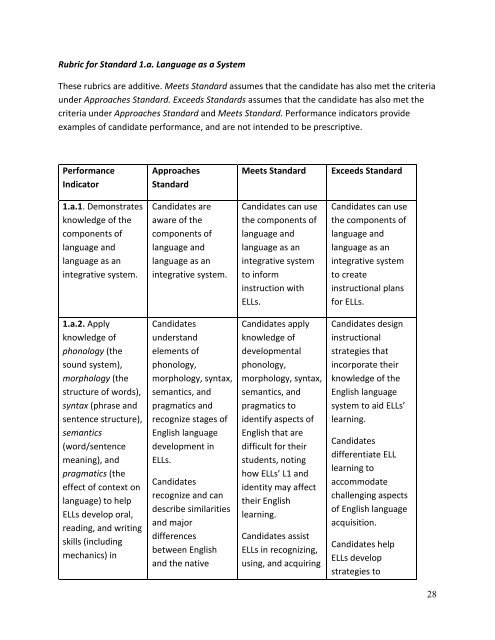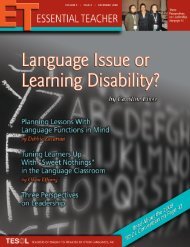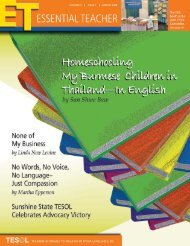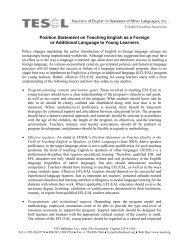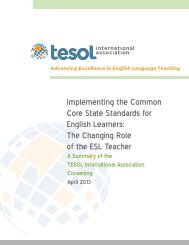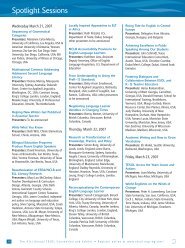Standards for the Recognition of Initial TESOL Programs
Standards for the Recognition of Initial TESOL Programs
Standards for the Recognition of Initial TESOL Programs
You also want an ePaper? Increase the reach of your titles
YUMPU automatically turns print PDFs into web optimized ePapers that Google loves.
Rubric <strong>for</strong> Standard 1.a. Language as a System<br />
These rubrics are additive. Meets Standard assumes that <strong>the</strong> candidate has also met <strong>the</strong> criteria<br />
under Approaches Standard. Exceeds <strong>Standards</strong> assumes that <strong>the</strong> candidate has also met <strong>the</strong><br />
criteria under Approaches Standard and Meets Standard. Per<strong>for</strong>mance indicators provide<br />
examples <strong>of</strong> candidate per<strong>for</strong>mance, and are not intended to be prescriptive.<br />
Per<strong>for</strong>mance<br />
Indicator<br />
Approaches<br />
Standard<br />
Meets Standard<br />
Exceeds Standard<br />
1.a.1. Demonstrates<br />
knowledge <strong>of</strong> <strong>the</strong><br />
components <strong>of</strong><br />
language and<br />
language as an<br />
integrative system.<br />
Candidates are<br />
aware <strong>of</strong> <strong>the</strong><br />
components <strong>of</strong><br />
language and<br />
language as an<br />
integrative system.<br />
Candidates can use<br />
<strong>the</strong> components <strong>of</strong><br />
language and<br />
language as an<br />
integrative system<br />
to in<strong>for</strong>m<br />
instruction with<br />
ELLs.<br />
Candidates can use<br />
<strong>the</strong> components <strong>of</strong><br />
language and<br />
language as an<br />
integrative system<br />
to create<br />
instructional plans<br />
<strong>for</strong> ELLs.<br />
1.a.2. Apply<br />
knowledge <strong>of</strong><br />
phonology (<strong>the</strong><br />
sound system),<br />
morphology (<strong>the</strong><br />
structure <strong>of</strong> words),<br />
syntax (phrase and<br />
sentence structure),<br />
semantics<br />
(word/sentence<br />
meaning), and<br />
pragmatics (<strong>the</strong><br />
effect <strong>of</strong> context on<br />
language) to help<br />
ELLs develop oral,<br />
reading, and writing<br />
skills (including<br />
mechanics) in<br />
Candidates<br />
understand<br />
elements <strong>of</strong><br />
phonology,<br />
morphology, syntax,<br />
semantics, and<br />
pragmatics and<br />
recognize stages <strong>of</strong><br />
English language<br />
development in<br />
ELLs.<br />
Candidates<br />
recognize and can<br />
describe similarities<br />
and major<br />
differences<br />
between English<br />
and <strong>the</strong> native<br />
Candidates apply<br />
knowledge <strong>of</strong><br />
developmental<br />
phonology,<br />
morphology, syntax,<br />
semantics, and<br />
pragmatics to<br />
identify aspects <strong>of</strong><br />
English that are<br />
difficult <strong>for</strong> <strong>the</strong>ir<br />
students, noting<br />
how ELLs’ L1 and<br />
identity may affect<br />
<strong>the</strong>ir English<br />
learning.<br />
Candidates assist<br />
ELLs in recognizing,<br />
using, and acquiring<br />
Candidates design<br />
instructional<br />
strategies that<br />
incorporate <strong>the</strong>ir<br />
knowledge <strong>of</strong> <strong>the</strong><br />
English language<br />
system to aid ELLs’<br />
learning.<br />
Candidates<br />
differentiate ELL<br />
learning to<br />
accommodate<br />
challenging aspects<br />
<strong>of</strong> English language<br />
acquisition.<br />
Candidates help<br />
ELLs develop<br />
strategies to<br />
28


